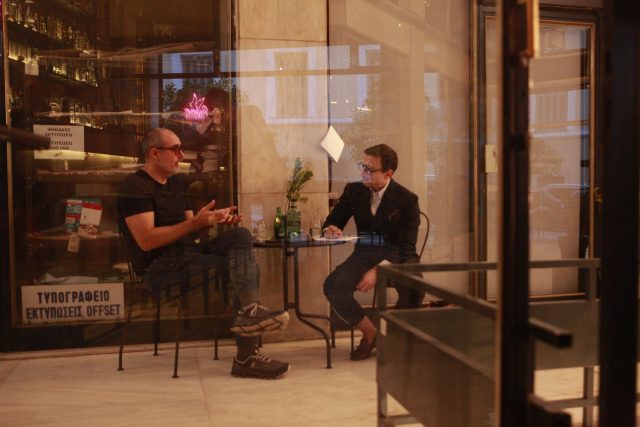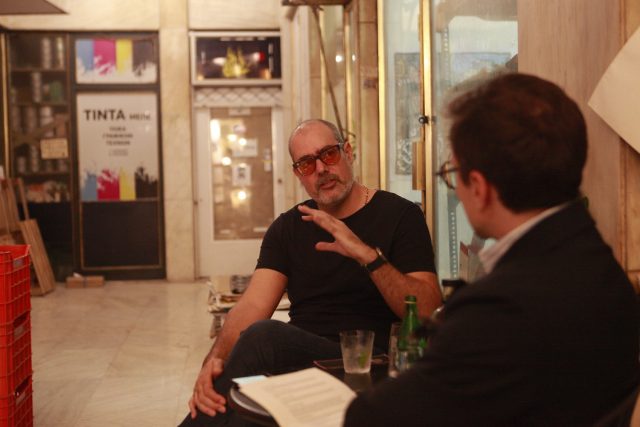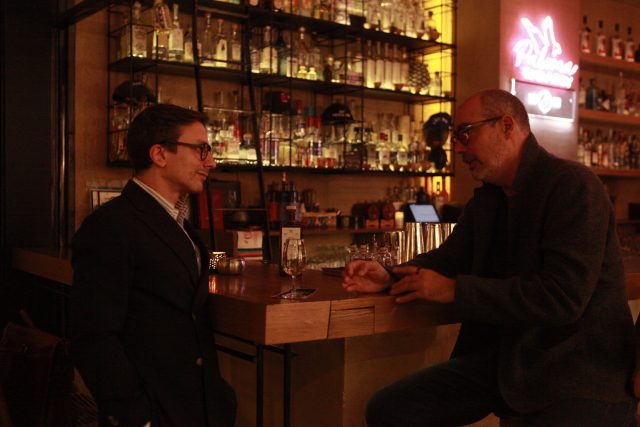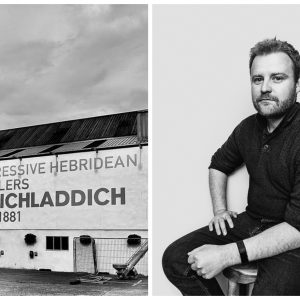“Innovation builds on the familiar”: Iván Saldaña on creativity, sustainability, and agave spirits
Γιαννης Κοροβεσης•Articles
This post is also available in: Greek
How did a university PhD transition from academia into the beverage industry and then collaborate with some of the world’s most famous celebrities? Mexican Dr. Iván Saldaña, with degrees in biochemistry and evolutionary plant biology, and a PhD from a European university, returned to Mexico to apply his knowledge of plants and to experiment. Along the way, he showcased Mexican culture and tradition. I met Dr. Iván Saldaña for a quick chat at Athens’ Barro Negro, where he was a guest of Granikal, the company that imports and distributes products from Casa Lumbre, the company he co-founded in 2017. The conversation lasted over an hour—inevitable when speaking to such a multifaceted individual, a true pioneer of agave spirits. Over the past decade, he has redefined the Mexican spirits industry, offering not just innovative drinks, but a new way of looking at the distillation process and the consumption of alcoholic beverages in general. I poured myself a glass of Nocheluna, the sotol he makes with… Lenny Kravitz, and we began our conversation.
Since founding Casa Lumbre in 2017, Dr. Saldaña has consistently kept us on our toes. His first spirit, a bold mezcal, arrived at a time when everyone was talking about wild agaves, yet he emphasized exclusively cultivated agave, specifically organic cultivation. It was the first brand to seriously talk about sustainability and one of the most transparent in its production. It’s no surprise that just two years later, one of the world’s largest beverage multinationals bought a majority stake in the company. But that wasn’t Casa Lumbre’s only partnership with big names.
Dr. Saldaña collaborated with Pernod Ricard three times—initially with the pioneering Mexican whiskey Abasolo, then the mezcal Ojo de Tigre, and most recently, the sotol Nocheluna. Pernod Ricard eventually invested in Casa Lumbre as a strategic partner.

But that’s not all! Casa Lumbre also created a series of gins called Gin de Las Californias, blending botanicals from both sides of the US-Mexico border. They teamed up with race car driver Lewis Hamilton to produce two alcohol-free agave drinks, the exceptional Almave. They developed three fantastic liqueurs: one from ancho chiles, another an orange liqueur called Alma Finca from Yucatán, and the Nixta corn liqueur, made using nixtamalization, a 4,000-year-old Aztec technique for processing corn. Recently, they launched a ready-to-drink margarita in a can with legendary Mexican boxer Canelo Álvarez! Can you see how impressive this guy is?
Before all these accomplishments in the beverage industry, Dr. Iván Saldaña Oyarzábal started his academic career at the University of Puebla, Mexico. As a student-researcher, he traveled extensively, living in Chile, Barbados, and Montreal, Canada, before completing his PhD at the University of Sussex, UK, focusing on plant biology and biochemistry. At some point, he became fascinated with agave as a research subject, naturally, as a Mexican, and began exploring fundamental questions about its evolutionary biology. For example, how can such a remarkable organism, which stores large amounts of water (and sugar) in a harsh environment, continue to survive when everything around it is trying to consume it to survive?
At that time, flavor or aroma hadn’t yet crossed his mind. He was purely focused on the evolutionary resilience of an organism that has survived for ten million years. Despite being full of sugars, no herbivores can consume agave because they can’t metabolize it. The complex carbohydrates in agave need to be broken down into simpler sugars, such as fructose and glucose, before they can be useful to other organisms—or to make alcohol through fermentation (hydrolysis).

“During the Mesoamerican period, native populations discovered another method to break down agave’s complex carbohydrates without roasting the plant’s heart over a fire,” he explained. Traditionally, they cut the central stalk of the plant and scraped its “heart” (tlachique). This stressed the plants, activating specific enzymes that broke down the complex carbohydrates into simple sugars. These sugars then fermented naturally with environmental yeasts. “That’s what interested me, until I made my next career change and entered the world of spirits.”
I asked him whether that’s when his interest in Mexican cultural heritage began and how he found modern ways to promote it. After all, this is what Casa Lumbre seems to do—striking a balance between honoring tradition and innovating in a competitive global market, right?
“Want to try an old-fashioned with Abasolo? It’s a great way to give a classic cocktail a beautiful Mexican character, to express our culture,” he said. “Absolutely!” I replied.
Dr. Saldaña explained that innovation is an inherent trait of both his generation and Casa Lumbre. As a young man, he and his friends were happy drinking Absolut with orange or enjoying McDonald’s, and on rare occasions, indulging in French, Italian, or Japanese fine dining. At the time, Mexican fine dining didn’t exist. Today, through the company they built, they don’t find excitement in pretending to be something they’re not. They don’t aspire to live like the French, Swiss, or Americans. Instead, they want to express themselves through products that reflect locality, a trend that’s increasingly popular today.
With Casa Lumbre, they decided to use elements and ingredients from Mexican tradition, including things previously seen as inferior or meant only for the poor, and present them in high quality, creating a different experience.

When he began working with agave, it coincided with the first major blue agave crisis in the early 2000s, when tequila was just starting to gain global attention. He was hired by Allied Domecq to work in the research department on the Sauza tequila brand. During this time, Pernod Ricard acquired Allied Domecq, and many of its brands were divided up. Sauza went to Fortune Brands (now part of Suntory Global Spirits), but Pernod Ricard kept Dr. Saldaña, placing him in charge of their research lab in Mexico City. There, he began studying agave more deeply and experimenting with new products.
“Innovation requires great care!” he warned. “You can’t innovate just by offering something completely foreign or out of the box because if you do, it’ll just be nonsense. No one will connect with it. Innovation has to touch on something familiar to the consumer. If you don’t connect your innovation to something philosophical, emotional, or material that the consumer can relate to, it risks being misunderstood or meaningless.”
Given the high demand for tequila and mezcal, industries where the raw material takes years to grow, I asked whether it was possible to run a sustainable business. He confidently answered, “Yes.”
“Every sustainability issue has a specific solution that must be implemented, provided that we’ve already decided we want our business model to be fully sustainable. You can clearly create a medium-sized brand sustainably, and under certain conditions, even larger brands. However, there is no one-size-fits-all solution for all brands and categories of spirits.”
Even when collaborating with celebrities or large distribution companies that can quickly scale a brand’s reach, you can still be entirely sustainable. From the outset, with their first mezcal, they had a clear goal—not only for the flavor but for every aspect of the production process. They set strict criteria for what a modern and high-quality product should be and stuck to them. It was always meant to be organically certified by the EU, the US, and Mexico. They also used only cultivated agaves. “Anyone using wild agaves, including some big companies, is irresponsible. You’re destroying nature. And I’m not referring to small, family-run distilleries, but to those who harvest wild plants to grow their brands rapidly.”
We also discussed organic farming as a cornerstone of a sustainable model for agave spirits. Dr. Saldaña highlighted the long-term investment and risk due to the time it takes for the plant to mature. This makes responsible and sustainable cultivation methods even more crucial to reduce environmental damage and preserve natural resources.
“There’s always the fast and easy way, with herbicides and pesticides,” he said. “But today, there are more innovative, effective, and eco-friendly methods.” In their plantations, they’ve deployed drones to map plants with infrared aerial photos, enabling them to assess each plant’s nutritional needs without overusing nitrogen fertilizers, as is done in other plantations.
Moreover, they emphasize cover crops, planting papaya, lime, and tomatillo trees to help prevent weed growth, while also providing farmers and local communities with extra income.
Dr. Saldaña emphasized that despite concerns about the environmental impact of increased agave spirit production, agave remains an extremely sustainable crop compared to others like corn or sugarcane. Casa Lumbre shares its expertise with other brands in the industry.

The path wasn’t always easy for Dr. Saldaña. He explained that he faced challenges, especially early on, as possibly the first to create what he calls an “Author Mezcal,” similar to the concept of “Author Wine”—a modern, contemporary mezcal with the personal signature of its creator, quite different from traditional versions. Naturally, he encountered significant resistance and skepticism in the market. The authenticity and value of his product were questioned. He had to travel the world, meeting with consumers and professionals in person to explain everything about his brand.
“You’re a former academic, now a master distiller, entrepreneur, and businessman. What’s your relationship with alcohol? Do you enjoy a glass of mezcal, tequila, or wine? I imagine you don’t get drunk,” I asked.
“Look, sometimes I might get carried away a little, but generally, when you’re constantly around alcohol and working to build a reputation, you learn to set limits and control yourself. You also learn to enjoy it consciously. It’s not always easy—being on the other side of the world, like here in Greece, as a free man (though I have two young children), in such an amazing place, enjoying Santorini wines and having to restrain yourself. You have to manage your behavior amidst all this beauty, not lose yourself in the excitement and intensity. But overall, you need to reflect on how you relate not only to alcohol but to the different places, people, and experiences—it should always be in a way that doesn’t negatively impact your health.”
It’s worth noting that Dr. Iván Saldaña loves wine, almost as much as he loves a good mezcal. Both beverages, he says, hold a place among the two ultimate alcoholic pleasures. A glass of wine with lunch and a glass of mezcal by the sea, watching the sunset.
The conversation had gone on longer than expected, and based on everything I’d heard, I was curious to ask what he would do if a tsipouro producer approached him for a collaboration. “Why not?” he replied. After all, he’s made Irish whiskey too. Plus, he loves the sea. For now, though, Casa Lumbre’s immediate plans include further developing their line of non-alcoholic products like Almave, where there’s ample room for experimentation. I couldn’t gather more details, but I’m confident that both he and his company will continue to surprise us for many years to come!
– AI generated translation





